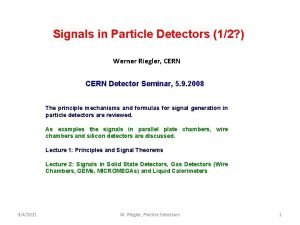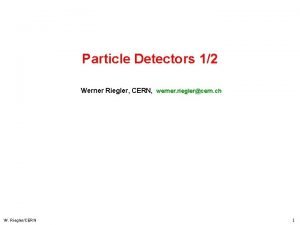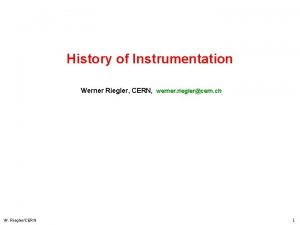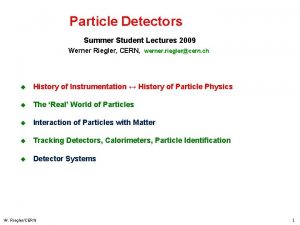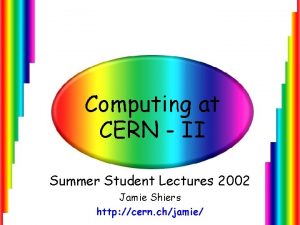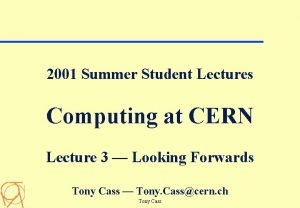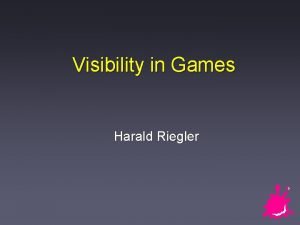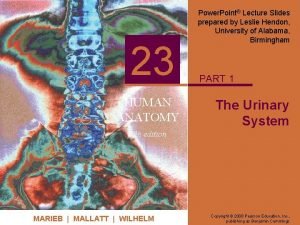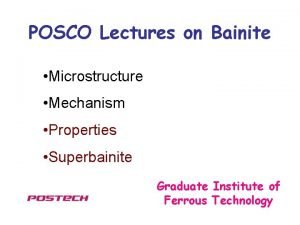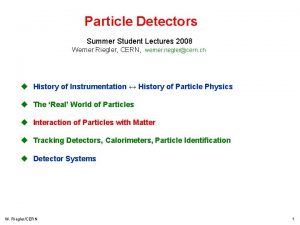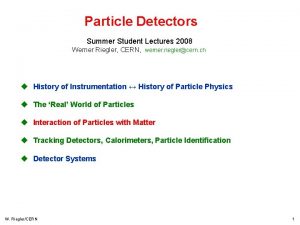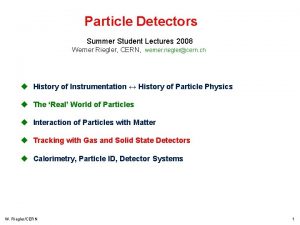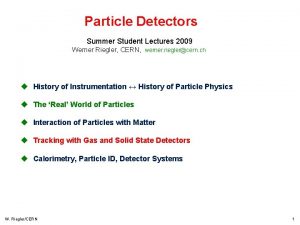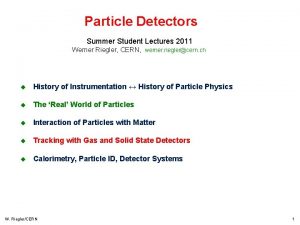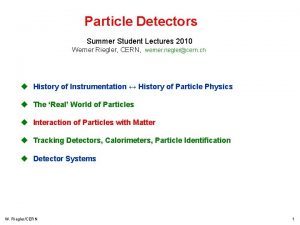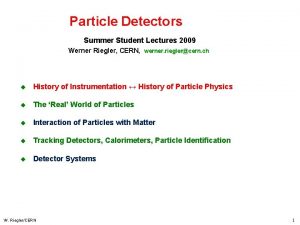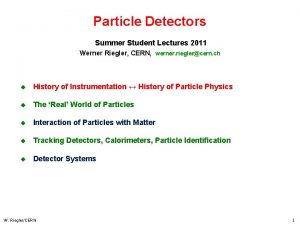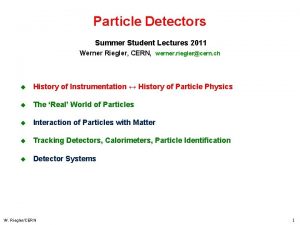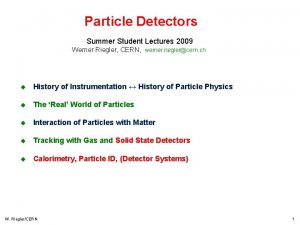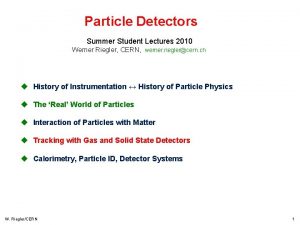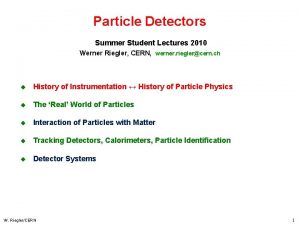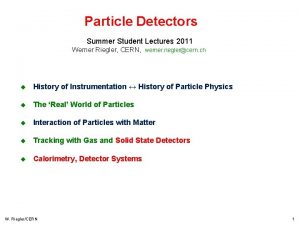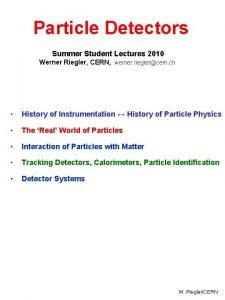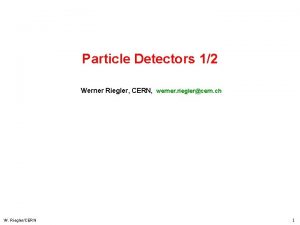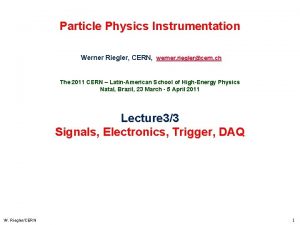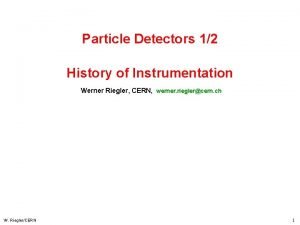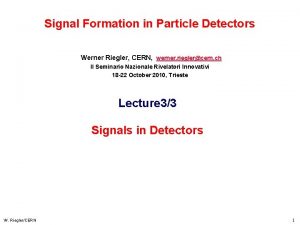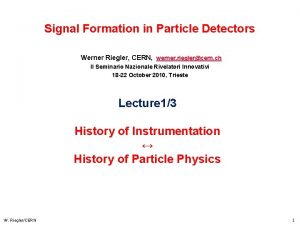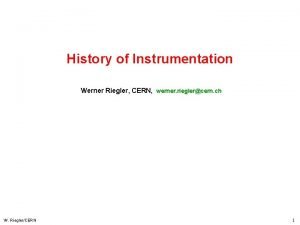Particle Detectors Summer Student Lectures 2008 Werner Riegler








































- Slides: 40

Particle Detectors Summer Student Lectures 2008 Werner Riegler, CERN, werner. riegler@cern. ch • History of Instrumentation ↔ History of Particle Physics • The ‘Real’ World of Particles • Interaction of Particles with Matter • Tracking Detectors, Calorimeters, Particle Identification • Detector Systems W. Riegler/CERN

The ‘Real’ World of Particles Elektro-Weak Lagrangian Higgs Particle W. Riegler/CERN

The ‘Real’ World of Particles W. Riegler/CERN

W. Riegler/CERN

W. Riegler/CERN

W. Riegler/CERN

W. Riegler/CERN

W. Riegler/CERN

W. Riegler/CERN

Build your own Accelerator Ekin= 1. 5 e. V = 2 615 596 km/h + 1. 5 V _ e- W. Riegler/CERN

Ekin=mc 2 mc 2( -1)=mc 2 =2 =0. 87 W. Riegler/CERN

W. Riegler/CERN

W. Riegler/CERN

W. Riegler/CERN

W. Riegler/CERN

W. Riegler/CERN

W. Riegler/CERN

W. Riegler/CERN

W. Riegler/CERN

W. Riegler/CERN

W. Riegler/CERN

W. Riegler/CERN

W. Riegler/CERN

W. Riegler/CERN

W. Riegler/CERN

ATLAS CMS LHCb ALICE W. Riegler/CERN

W. Riegler/CERN

W. Riegler/CERN

W. Riegler/CERN

W. Riegler/CERN

Z e+ e. Two high momentum charged particles depositing energy in the Electro Magnetic Calorimeter W. Riegler/CERN

Z μ+ μTwo high momentum charged particles traversing all calorimeters and leaving a signal in the muon chambers. W. Riegler/CERN

Z t + t - m+ n - e - n 1 or 2 secondary vertives, high momentum electron, high momentum muon, missing momentum. W. Riegler/CERN

Z qq Two jets of particles W. Riegler/CERN

Z qqg Three jets of particles W. Riegler/CERN

Two secondary vertices with characteristic decay particles giving invariant masses of known particles. Bubble chamber like – a single event tells what is happening. Negligible background. W. Riegler/CERN

ALEPH Higgs Candidate Undistinguishable background exists. Only statistical excess gives signature. W. Riegler/CERN

Cosmic Shower of Muons W. Riegler/CERN

Higgs Boson at CMS Particle seen as an excess of two photon events above the irreducible background. W. Riegler/CERN

Conclusion: Only a few of the numerous known particles have lifetimes that are long enough to leave tracks in a detector. Most of the particles are measured though the decay products and their kinematic relations (invariant mass). Most particles are only seen as an excess over an irreducible background. Some short lived particles (b, c –particles) reach lifetimes in the laboratory system that are sufficient to leave short tracks before decaying identification by measurement of short tracks. In addition to this, detectors are built to measure the 8 particles Their difference in mass, charge and interaction is the key to their identification. W. Riegler/CERN
 Werner riegler cern
Werner riegler cern Particle detector
Particle detector Werner riegler
Werner riegler Werner riegler
Werner riegler Cern summer student lectures
Cern summer student lectures Cern summer school lectures
Cern summer school lectures Medical emergency student lectures
Medical emergency student lectures Hematology medical student lectures
Hematology medical student lectures 2008 2008
2008 2008 Harald riegler
Harald riegler Feature detectors
Feature detectors Vhv voltage detectors
Vhv voltage detectors Where are feature detectors located
Where are feature detectors located Giant wave detectors murmurs universe
Giant wave detectors murmurs universe Yodsawalai chodpathumwan
Yodsawalai chodpathumwan Frontier detectors for frontier physics
Frontier detectors for frontier physics Photo detectors
Photo detectors Kinesthesis and vestibular sense
Kinesthesis and vestibular sense Giant gravitational wave detectors hear murmurs
Giant gravitational wave detectors hear murmurs What is thermal detector
What is thermal detector Nuclear detectors
Nuclear detectors Feature vectors
Feature vectors Streaming potential
Streaming potential Hplc detector types
Hplc detector types Theory of translation lectures
Theory of translation lectures Tamara berg husband
Tamara berg husband Introduction to web engineering
Introduction to web engineering Hugh blair lectures on rhetoric
Hugh blair lectures on rhetoric Lectures paediatrics
Lectures paediatrics Slagle lecture
Slagle lecture Nuclear medicine lectures
Nuclear medicine lectures Introduction to recursion
Introduction to recursion Cs614 short lectures
Cs614 short lectures Radio astronomy lectures
Radio astronomy lectures Anatomy lectures powerpoint
Anatomy lectures powerpoint Bhadeshia lectures
Bhadeshia lectures C programming lectures
C programming lectures Power system lectures
Power system lectures Digital logic design lectures
Digital logic design lectures Do words have power
Do words have power Pathology lectures for medical students
Pathology lectures for medical students
